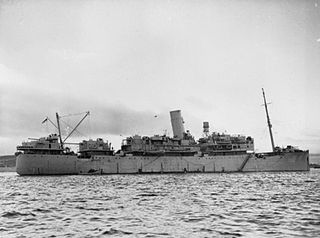
HMS Cheshire was a passenger ship that was built in Scotland in 1927 and scrapped in Wales in 1957. She belonged to Bibby Line, which ran passenger and cargo services between Rangoon in Burma and various ports in Great Britain, via the Suez Canal and Gibraltar. The Admiralty requisitioned her in 1939 and had her converted into an armed merchant cruiser (AMC). She was converted into a troopship in 1943, and returned to civilian service in 1948.
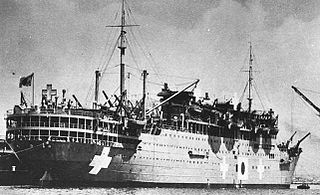
MS Aramis was a Messageries Maritimes ocean liner that was launched in France in 1931. She was a sister ship of Félix Roussel and Georges Philippar. The three sisters were highly unusual in having square funnels. Aramis' interior was an Art Deco interpretation of Minoan design.
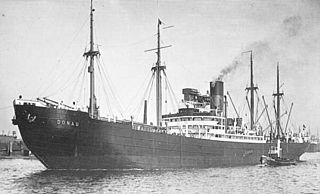
SS Donau was a Norddeutscher Lloyd (NDL) refrigerated cargo steamship that was built in Germany in 1929 and sunk in occupied Norway in 1945. In the 1930s she sailed mostly between Bremen and the West Coast of the United States via the Panama Canal.
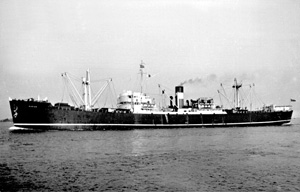
SS Empire Galahad was a refrigerated cargo ship built in 1942 and scrapped in 1967. She was also called SS Celtic Star (1946), SS Murillo (1946–52), SS Bogliasco (1952–54), MV Bogliasco (1954–63) and MV Ocean Peace (1963–67). She was built as a steamship, but in 1954 she was converted into a motor ship. She was scrapped in Taiwan in 1967.
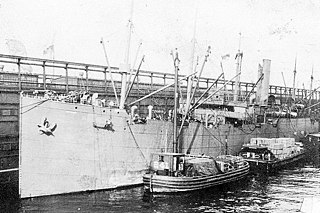
Empire Bittern was a steamship, built as a livestock-carrying cargo ship in 1902 at Belfast, Ireland as Iowa for the White Diamond Steamship Company Ltd of Liverpool. The ship was sold to the Hamburg America Line and renamed Bohemia in 1913.
SS Manistee was an Elders & Fyffes Ltd banana boat that was launched in 1920. She was one of a numerous class of similar banana boats built for Elders & Fyffes in the 1920s.

SS Hilary was a British steam passenger liner that was built in 1931 and scrapped in 1959. She spent much of her career on a scheduled service between Liverpool in England and Manaus in Brazil.
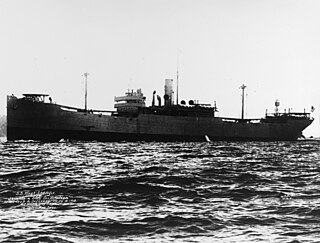
USS West Lianga (ID-2758) was a cargo ship for the United States Navy during World War I. She was later known as SS Helen Whittier and SS Kalani in civilian service under American registry, as SS Empire Cheetah under British registry, and as SS Hobbema under Dutch registry.
Empire Antelope was a 4,782-ton cargo ship which was built as Ophis in 1919. She was renamed Bangu in 1928. In 1941 she was renamed Empire Antelope. She was sunk by the German submarine U-402 on 2 November 1942.
MV Domala was a British cargo liner that was launched in 1920 as Magvana, but completed in 1921 as Domala. She was the first major ocean-going passenger ship to be built in the United Kingdom as a motor ship.
SS Empire Bunting was a 6,318 GRT cargo ship which was built in 1919. She saw service between the wars under the US flag and was transferred to the UK Ministry of War Transport in the Second World War. She made a number of cross-Atlantic voyages, often sailing in convoys. She ended her career by being sunk as a blockship on the Normandy coast, supporting the allied landings there in 1944.
Empire Blanda was a cargo ship that Lithgows Ltd, Port Glasgow built in 1919 as Nile. It was sold to a Yugoslavian company in 1930 and renamed Sokol in 1933, serving until 1939 when it was sold to a Panamanian company and renamed Rio Grande. In 1940, the Ministry of War Transport (MoWT) requisitioned Nile, which was renamed Empire Blanda. On 19 February 1941 U-69 torpedoed Nile, sinking it.
Empire Blessing was a cargo ship which was built in 1943 by Bartram & Sons Ltd, Sunderland. She was built for the Ministry of War Transport (MoWT) and operated under the management of W Runciman & Co Ltd. In March 1945, Empire Blessing struck a mine in the Scheldt and sank.
Belgian Captain was a 7,041 GRT cargo ship which was built in 1942 as Empire Centaur for the Ministry of War Transport (MoWT). In 1943 she was passed to the Belgian Government and renamed Belgian Captain. Postwar, she was sold into merchant service and renamed Capitaine Lambe. In 1960 she was sold to Hong Kong and renamed Ardee, being renamed Alpha Trader in 1964. She served until 1967 when she was scrapped.
SS Empire Chamois was a 5,864 GRT cargo ship which was built in 1918 by Ames Shipbuilding and Drydock Co, Seattle. She was ordered by the Compagnie Générale Transatlantique but was requisitioned by the United States Navy and commissioned as USS West Mount with the pennant number ID-3202 in 1918. She was decommissioned in May 1919 and passed to the United States Shipping Board (USSB) as SS Westmount. In 1927 she was sold to the Dimon Steamship Corporation and renamed SS Pacific Redwood. She returned to the USSB in 1932 and passed to the United States Maritime Commission (USMC) in 1937. In 1940, she was passed to the Ministry of Shipping, passing to the Ministry of War Transport in 1941 and being renamed SS Empire Chamois. She was sold to Astral Shipping Co Ltd in 1946 and renamed SS Granview. In 1949 she was sold to the Compagnia Maritime del Este, Panama and renamed SS Chamois, serving until 1958 when she was scrapped. She was the last Ames-built ship afloat.

SS Polar Chief was a merchant steamship that was built in England in 1897 and scrapped in Scotland in 1952. In her 55-year career she had previously been called Montcalm, RFA Crenella, Crenella, Rey Alfonso, Anglo-Norse and Empire Chief. Early in the First World War she spent eight months pretending to be the battleship HMS Audacious.
Belgian Crew was a 7,048 GRT cargo ship which was built in 1942 by Sir W G Armstrong, Whitworth & Co (Shipbuilders) Ltd, Newcastle upon Tyne as Empire Claymore for the Ministry of War Transport (MoWT). She was transferred to the Belgian Government in 1943 and renamed Belgian Crew. In 1946 she was sold to Compagnie Maritime Belge and renamed Capitaine Parlet. In 1960 she was sold to Hong Kong and renamed Ardenode. A further sale to Panama in 1966 resulted in her being renamed Tynlee. She served until 1969, when she was scrapped.
Empire Dorado was a 5,595 GRT design 1019 cargo ship that was built in 1920 as Tolosa by Atlantic Corporation, Portsmouth, New Hampshire, United States for the United States Shipping Board (USSB), passing to the United States Maritime Commission (USMC) in 1937. She was sold to the United Kingdom in 1940, passed to the Ministry of War Transport (MoWT) and renamed Empire Dorado. She served until November 1941, when she was in collision with another ship. Although taken in tow, she subsequently sank.
SS Verdala was a cargo and passenger steamship that was built in Scotland in 1913. Several times she changed owners and was renamed: as Mongolian Prince in 1917, Istok in 1928 and finally Maycrest in 1940.

Empire Mariner was a cargo steamship. She was built in Germany in 1922 for Hamburg America Line (HAPAG), who named her Schwarzwald. In 1935 H. Vogemann bought her and renamed her Rheingold. In October 1939 a Royal Navy cruiser captured her, and the United Kingdom government renamed her as the Empire ship Empire Mariner. She survived numerous transatlantic convoys in the Battle of the Atlantic. In 1946 South American Saint Line bought her and renamed her Saint Ina. In 1948 Bristol City Line bought her and renamed her Wells City. In 1951 the Pakistani-owned East & West Steamship Company bought her and renamed her Fausta. She was scrapped in Pakistan in 1964.










